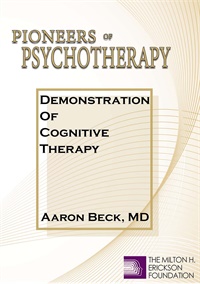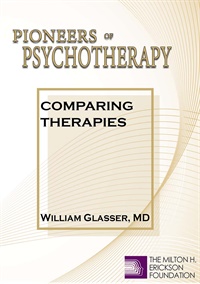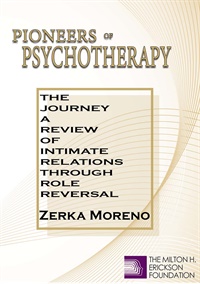
Credit available - Click Here for more information
- Average Rating:
- Not yet rated
- Topic Areas:
- Clinical Demonstrations | Abuse | Addiction | Psychotherapy | Role Play | Cognitive Behavior Therapy (CBT) | Relationships
- Bundle(s):
- Pioneers of Psychotherapy Bundle
- Categories:
- Pioneers of Psychotherapy | Online Continuing Education | Evolution of Psychotherapy | Evolution of Psychotherapy 1995
- Faculty:
- Aaron Beck, MD
- Course Levels:
- Master Degree or Higher in Health-Related Field
- Duration:
- 00:59:00
- Format:
- Audio and Video
- Original Program Date:
- Dec 15, 1995
- Short Description:
- Aaron Beck (1995) selects a clinician to role-play a male client. The client, Mike, was abandoned by his wife after she had multiple affairs. Mike is a recovering alcoholic with a sexually transmitted disease who suffers from dating anxiety, childhood trauma, and feelings of inferiority. Beck demonstrates how to establish a collaborative relationship with the patient.
- Price:
- $59.00 - Base Price

- Average Rating:
- Not yet rated
- Topic Areas:
- Short Courses | Reality Therapy | Brief Therapy | Role Play
- Categories:
- Brief Therapy Conference | Brief Therapy Conference 2010
- Faculty:
- Robert Wubbolding, EdD
- Duration:
- 1:28:33
- Format:
- Audio Only
- Original Program Date:
- Dec 09, 2010
- Short Description:
- Simulated role-play demonstrations, the focus of this session, illustrate the re-invented use of the WDEP system of reality therapy. A brief explanation of how reality therapy embraces principles of suggestion, reorientation and utilization precedes a brief overview of human motivation and how the WDEP system interfaces with Ericksonian Principles. Participants will gain practical ideas immediately useful on the job. Handouts suitable for photocopying will be provided.
- Price:
- $15.00 - Base Price

- Average Rating:
- Not yet rated
- Topic Areas:
- Clinical Demonstrations | Role Play | Psychotherapy
- Bundle(s):
- Pioneers of Psychotherapy Bundle
- Categories:
- Pioneers of Psychotherapy | Evolution of Psychotherapy | Evolution of Psychotherapy 2000
- Faculty:
- William Glasser, MD
- Course Levels:
- Master Degree or Higher in Health-Related Field
- Duration:
- 00:56:00
- Format:
- Audio and Video
- Original Program Date:
- May 27, 2000
- Short Description:
- William Glasser (2000) uses role-play with Marie who is simulating Paul, a male client from her place of employment. Paul has marriage problems. Marie, as Paul, is asked to role-play his wife. Glasser highlights choices, examines the client’s thinking, and focuses on responsible behavior. After the demonstration Glasser explains his work.
- Price:
- $59.00 - Base Price

- Average Rating:
- Not yet rated
- Topic Areas:
- Clinical Demonstrations | Psychodrama | Psychotherapy | Role Play | Art and Creativity
- Bundle(s):
- Women Pioneers of Psychotherapy | Pioneers of Psychotherapy Bundle
- Categories:
- Pioneers of Psychotherapy | Evolution of Psychotherapy | Evolution of Psychotherapy 2000
- Faculty:
- Zerka Moreno
- Course Levels:
- Master Degree or Higher in Health-Related Field
- Duration:
- 01:01:00
- Format:
- Audio and Video
- Original Program Date:
- May 27, 2000
- Short Description:
- Zerka Moreno (2000) emphasizes the importance of spontaneity and creativity while demonstrating with Christi, who is asked to see her family photo and then construct it on stage using volunteers from the audience. These volunteers act as “auxiliary egos.” Following this demonstration Moreno plays all of the characters in a rolereversal she did with her 3 year-old son.
- Price:
-
Nate Sub 1.1 Price is $0.00
price reduced from Base Price - $59.00

Credit available - Click Here for more information
- Average Rating:
- Not yet rated
- Topic Areas:
- Clinical Demonstrations | Intimacy | Relationships | Psychotherapy | Role Play
- Bundle(s):
- Women Pioneers of Psychotherapy | Pioneers of Psychotherapy Bundle
- Categories:
- Pioneers of Psychotherapy | Evolution of Psychotherapy | Evolution of Psychotherapy 1985
- Faculty:
- Zerka Moreno
- Course Levels:
- Master Degree or Higher in Health-Related Field
- Duration:
- 01:01:00
- Format:
- Audio and Video
- Original Program Date:
- Dec 12, 1985
- Short Description:
- Zerka Moreno (1985) explains the importance of role reversal. She demonstrates with Lori who discusses concerns related to her marriage. She examines her relationship with her father. Lori is asked to create a family structure using members from the audience. Moreno ends by sharing information about her own experiences in Psychodrama.
- Price:
- $59.00 - Base Price

